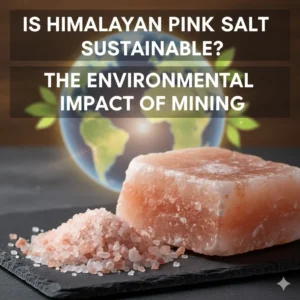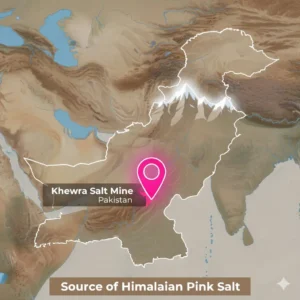Himalayan pink salt is a naturally occurring mineral known for its rose hue and trace mineral content, mined primarily from the Khewra region of Pakistan. Its distinctive appearance and perceived purity have made it a premium choice for food, wellness, and home products. However, assessing its true value requires examining the sustainability of its extraction and global transport. This article outlines how mining practices, energy use, and trade ethics influence the environmental footprint of Himalayan pink salt and offers guidance for more responsible sourcing decisions.

Understanding the Origins of Himalayan Pink Salt
Evaluating the sustainability and ethics of Himalayan pink salt begins with knowing its geographic and production roots. Its source, extraction methods, and long transportation routes all influence environmental impact, carbon footprint, and fair trade conditions within the global supply chain.
- Location: Mined from Pakistan’s Khewra Salt Mine, one of the world’s oldest and largest active salt deposits.
- Mining Method: Combines traditional hand-mining with selective mechanical extraction to reach deep seams while maintaining control over output and site stability.
- Product Range: Encompasses raw salt blocks, culinary slabs, decorative lamps, and refined crystals prepared for international distribution.
- Transportation: A major contributor to environmental impact, as heavy bulk shipments travel long distances, generating substantial carbon emissions through freight logistics.

Recognizing these origin factors is essential to understanding the true sustainability profile of Himalayan pink salt—linking its natural appeal to measurable ethical and environmental costs.
Step-by-Step Guide to Assessing the Environmental Impact of Salt Mining
Step 1: Examine Mining Methods and Land Impact
Begin by evaluating how the salt is extracted, as mining techniques differ in their effects on local ecosystems. Manual extraction minimizes disruption, whereas blasting or heavy machinery can destabilize terrain and reduce biodiversity. In regions such as Khewra, it is essential to assess how excavation alters the land surface and surrounding vegetation.
Although salt extraction generally avoids chemical use, it can still reshape landscapes and trigger soil erosion or ground instability. Understanding these physical changes helps determine each mine’s overall environmental integrity.
Step 2: Measure Carbon Footprint and Transportation Emissions
Assess the total energy consumed during extraction, processing, and shipment. Himalayan pink salt travels thousands of kilometers to reach export markets, generating substantial transportation emissions. Mapping each shipping stage reveals where the largest energy and carbon costs occur.
Emissions from mining operations and fossil-fuel-based transport combine to form a significant carbon footprint. Partnering with suppliers that disclose energy sources and prioritize cleaner logistics can meaningfully lower the environmental burden of global distribution.
Step 3: Analyze Water Consumption and Pollution Risks
Review how water is used to clean or refine salt, as the process may release saline wastewater into nearby rivers or soil. Such discharges can elevate salinity levels and disrupt aquatic ecosystems if untreated. Tracking total freshwater demand helps identify opportunities for conservation and efficiency.
Progressive producers now recycle process water or treat effluents prior to discharge. Verifying these systems and their performance clarifies whether a mine upholds responsible water management practices that protect surrounding ecosystems.
Step 4: Assess Social and Economic Responsibility
Sustainability extends beyond environmental factors to include social well-being. Examine working conditions, pay equity, and community relations near mining areas like Khewra. Ethical operations depend on safe environments, fair wages, and the absence of exploitation.
Determine whether mining businesses contribute positively to local economies, ensuring that workers and communities benefit from global demand. Third-party certifications and transparent sourcing statements further validate that a supplier aligns with fair trade standards and sustainable development objectives.
Authentic Himalayan Salt Blocks for B2B Partnerships
Collaborate with Jilin Ever Creation to source Himalayan salt blocks mined under responsible and transparent practices. Each food-grade block is produced in accordance with fair trade principles and sustainable extraction methods, helping reduce the carbon footprint associated with global transport.
Select from tailored sizes, shapes, and packaging designed for culinary, retail, or hospitality use. By choosing a partner committed to environmental responsibility, your brand can deliver genuine quality while supporting ethical mining and equitable trade.

Environmental Effects: Land Degradation and Water Contamination
Himalayan pink salt mining alters the physical landscape, contributing to soil erosion and reduced ground stability. Although less damaging than metal or coal extraction, the repeated removal of material weakens topsoil and hinders natural land recovery. Extensive underground workings can also disturb vegetation and disrupt drainage patterns around the mining areas.
Processing the salt consumes significant water for washing and refining. When residual saline or mineral-rich wastewater enters nearby rivers or groundwater, it can raise salinity levels, diminish soil fertility, and harm aquatic ecosystems. Implementing effective wastewater treatment and monitoring practices is essential to prevent these long-term environmental impacts.
Several producers are adopting land restoration and water recycling measures to minimize their ecological footprint. While these initiatives do not eliminate the effects of mining, they represent measurable progress toward responsible resource management and the protection of local ecosystems.
Carbon Emissions and Climate Impact of Salt Transportation
Transporting Himalayan pink salt across intercontinental routes generates significant greenhouse gas emissions. The mineral’s density and shipping volume result in a substantial carbon footprint, driven by both travel distance and freight weight. Although the salt itself is a natural product, the high energy consumption required for global distribution challenges its reputation as a sustainable material.
Extraction and processing contribute additional emissions because operations often rely on fossil fuels. This combination of long-distance shipping and energy-intensive production underscores legitimate concerns about supply chain accountability and environmental responsibility.
Businesses and consumers seeking to minimize their carbon footprint can prioritize suppliers with verified fair trade and sustainability certifications, transparent logistics data, or measurable carbon reduction programs. Opting for regionally sourced salts further cuts transport emissions while supporting more balanced, responsible trade practices.
Certifications and Ethical Practices to Look For
When evaluating Himalayan pink salt suppliers, third-party certifications offer clear evidence of sustainable and ethical sourcing. Labels such as Fair Trade confirm that workers receive fair wages and operate under safe labor conditions, while programs like Friend of the Sea signal responsible water management and minimal ecological disturbance throughout extraction and processing.
Equally important is how openly a brand discloses its practices. Companies that share verifiable information about their mining sites, labor standards, and carbon reduction efforts demonstrate a measurable commitment to transparency. This visibility helps buyers ensure that their products come from operations actively working to lower environmental impact and strengthen local communities.
Ultimately, ethical sourcing extends beyond product quality—it reflects a brand’s accountability in advancing fair trade, reducing ecological harm, and safeguarding natural resources for the future.
Frequently Asked Questions About Himalayan Pink Salt Sustainability
Is Himalayan salt mining harmful to the environment?
Mining Himalayan pink salt has measurable environmental effects. The greatest concern is the carbon footprint generated by transporting a heavy mineral over long distances. Extraction also consumes energy and alters local terrain, though its ecological impact remains lower than that of chemical or metal mining operations.
Are miners at the Khewra Salt Mine compensated fairly?
Pay and workplace standards can differ among contractors at the Khewra Salt Mine. Ethical brands partner with suppliers who guarantee fair wages, safe conditions, and welfare programs. Verifying fair trade or third-party certifications is the most reliable way to confirm responsible labor practices.
How is Himalayan salt transported from Pakistan to international markets?
Salt is first delivered by truck from the Khewra mine to nearby export terminals, then shipped overseas via freight vessels. The distance and weight of these shipments contribute significantly to its overall carbon footprint. Working with suppliers who invest in carbon offsetting or regional warehousing can help lower transport-related emissions.
Could Himalayan salt deposits eventually run out?
Himalayan salt comes from ancient geological formations that developed over millions of years, making it a non-renewable resource. Although reserves remain extensive, continued extraction will gradually reduce supply. Sustainable mining practices and moderate global consumption are essential to preserving the deposit for future generations.
What qualifies a salt brand as ethical or sustainable?
A genuinely ethical brand maintains supply chain transparency, ensures equitable labor standards, and minimizes ecological impact through responsible packaging and logistics. Reducing transport distances and adopting cleaner distribution methods further demonstrate environmental accountability. Recognized certifications or sustainability reports validate these commitments.
Final Thoughts
Understanding how Himalayan pink salt is mined and transported clarifies why sustainability concerns are justified. Extraction methods, global logistics, and water management each contribute to its overall environmental and ethical footprint, revealing the true cost behind what appears to be a simple natural product.
The industry is gradually improving through fair trade programs, energy-efficient mining, and transparent supply chains. Yet, the emissions generated by long-distance shipping remain a significant challenge that offsets some of these sustainability gains.
Partnering with suppliers committed to ethical labor and environmentally responsible sourcing helps minimize ecological impact while supporting community livelihoods. Informed purchasing choices ultimately drive the salt trade toward greater accountability and lasting sustainability.






